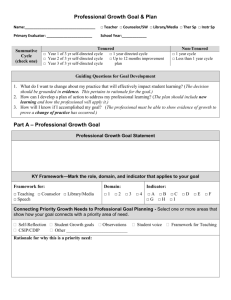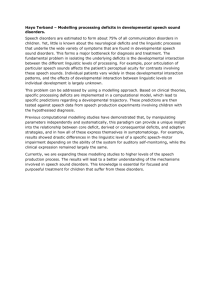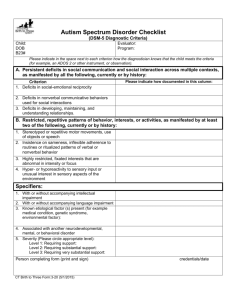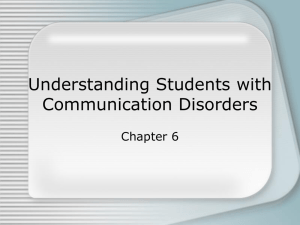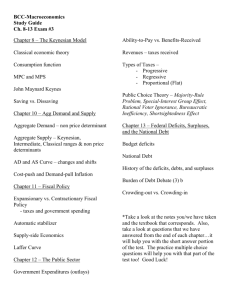Executive Functions Training Notes Colebrook High School Feb. 11
advertisement
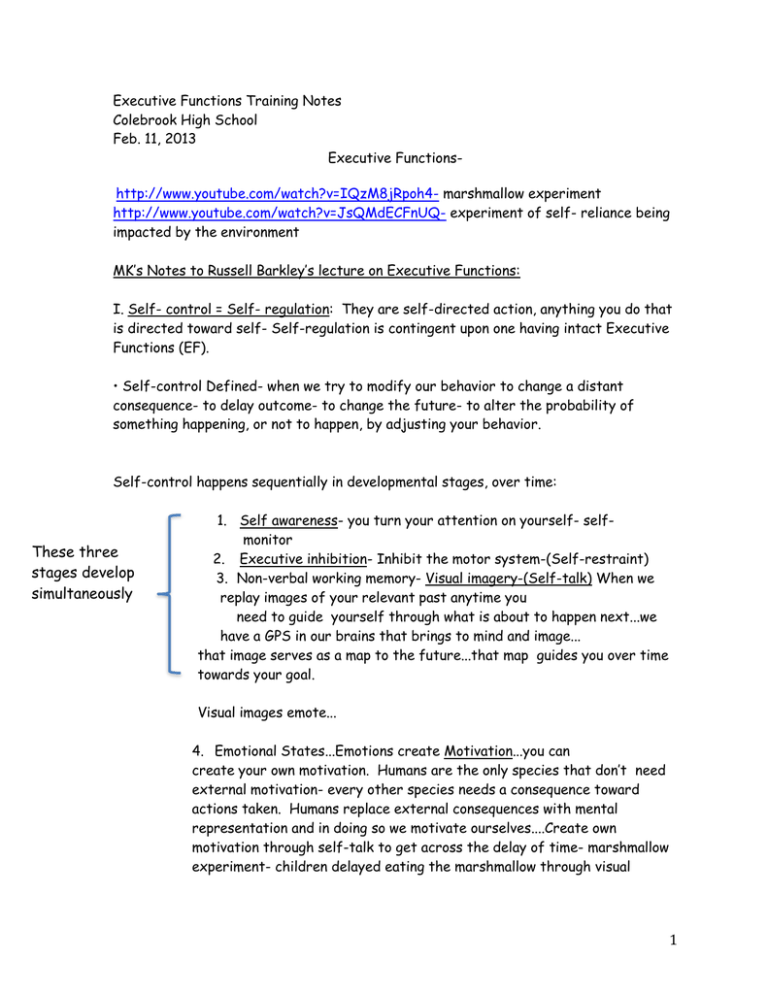
Executive Functions Training Notes Colebrook High School Feb. 11, 2013 Executive Functionshttp://www.youtube.com/watch?v=IQzM8jRpoh4- marshmallow experiment http://www.youtube.com/watch?v=JsQMdECFnUQ- experiment of self- reliance being impacted by the environment MK’s Notes to Russell Barkley’s lecture on Executive Functions: I. Self- control = Self- regulation: They are self-directed action, anything you do that is directed toward self- Self-regulation is contingent upon one having intact Executive Functions (EF). • Self-control Defined- when we try to modify our behavior to change a distant consequence- to delay outcome- to change the future- to alter the probability of something happening, or not to happen, by adjusting your behavior. Self-control happens sequentially in developmental stages, over time: These three stages develop simultaneously 1. Self awareness- you turn your attention on yourself- selfmonitor 2. Executive inhibition- Inhibit the motor system-(Self-restraint) 3. Non-verbal working memory- Visual imagery-(Self-talk) When we replay images of your relevant past anytime you need to guide yourself through what is about to happen next...we have a GPS in our brains that brings to mind and image... that image serves as a map to the future...that map guides you over time towards your goal. Visual images emote... 4. Emotional States...Emotions create Motivation...you can create your own motivation. Humans are the only species that don’t need external motivation- every other species needs a consequence toward actions taken. Humans replace external consequences with mental representation and in doing so we motivate ourselves....Create own motivation through self-talk to get across the delay of time- marshmallow experiment- children delayed eating the marshmallow through visual 1 imagery and self talk (imagine eating it, thought about the time they make s’mores. 5) Working Memory-Planning and Problem Solving...Children learn to do this through play...they manipulative the environment to see what happens. Problem solving is internal play...problems with working memory. Self-emote motivation and play with it. II. There are many different definitions for EF. Barkley believes most miss the mark in that they are too narrowly focused and do not convey an understanding of the pervasive impact EF deficits have on one’s “behavior, daily functioning social relations, cooperative ventures, economic transactions, and even moral, legal, occupational, childrearing, and community activities”. (Barkley 2012) Current assessments also do not assess EFs in their entirety, but rather only certain EF processes. EF is not a set of skills, but neuropsychological capacities or processes that function in concert with each other ( an EF system) needed to maintain goal directed problem solving. Critical to the definition is that there is a daily need to look ahead and anticipate what other are likely to do in the context of pursuing one’s own needs. Social abilities, emotional regulation, and motivation are not linked sufficiently to most EF definitionsEF contains “social executors” that serve certain social functions: 1) social regulation: processes needed to manage the initiation, rate, intensity and duration of social interactions 2) social self-awareness- knowledge and insight about ones self and the impact of one’s behavior on others in social settings 3) social sensitivity: The ability to understand another’s perspective, point of view, or emotional state (similar to empathy and theories of mind) and 4) social salience: regulation of somatic and emotional states that impart a sense of meaningfulness to social situations and to specific individuals within that situation (Barkley 2012). 2 III. We use Executive Functions to Self- Regulated in order to achieve goals• Each executive function can be considered to be a type or special form of selfregulation – a specific class of actions that people direct at themselves to change their behavior so as to alter a future consequence or likelihood of attaining a goal. •We can therefore take each EF that researchers have identified, and redefine it as a type of self-direct action: 1) Inhibition becomes self-awareness is self-directed attention, self restraint 2) Verbal working memory is self-speech (talking to yourself, usually using your mind’s voice), 3) Nonverbal working memory is seeing to yourself, or using visual imagery along with other forms of self-directed sensing (rehearing previous conversations to yourself, re-perceiving odors you previously smelled or flavors you previously tasted, etc.) and 4) Planning and Problem-solving could be thought of as self-directed play (taking apart and recombining things or ideas to create novel rearrangements). • By adulthood, all of these are largely invisible to others, or mental in form, such that the person engages in them privately, to themselves, in their mind (brain). • Working memory and problem-solving in fact are the ways people typically mentally represent and manipulate information that is being held in our mind (using images and words). In short, we use the various EFs for self-regulation to attain goals (alter future consequences). IV. There are 7 EFs: EXAMPLE: When you walk into a coffee shop and see a display counter filled with pastries or confections you face a situation that may tempt you to buy these things that are likely to ruin your plans for losing weight this month. To deal with this temptation while you wait for your coffee to be prepared, you may avert your eyes from the counter, walk to a different section of the shop away from the tempting goodies, engage yourself in mental conversation about why you need to not buy those products, and even visualize an image of the new slenderer version of yourself you expect to achieve in the near future. 3 All of these are self-directed actions you are using to try and alter the likelihood of giving into temptation and therefore increase your chances of meeting your goal of weight loss this month. This situation calls upon a number of distinct yet interacting mental abilities to successfully negotiate the situation. EF used in simple every day life tasks over and over again: 1) You had to be aware that a dilemma has arisen when you walked into the shop (self-awareness) 2) You had to restrain your urge to order the pastry to go with the coffee you have ordered (inhibition self-restraint) 3) You re-directed your attention away from the tempting objects (executive attention or attentional management), 4) You spoke to yourself using your mind’s voice (verbal self-instruction or working memory) 5) You visualized an image of your goal and what you would look like when you successfully attain it (nonverbal working memory, or visual imagery). 6) You may have found yourself thinking about various other ways you could have coped effectively with these temptations (problem solving) 7) You may have even used words of encouragement toward yourself to enhance the likelihood that you would follow your plan (self-motivation). V. EFs develop in phases over time sequentially• Early developments: • 0-3 years- language to others- external language • 3-5 years- Talk to self- speech directed back to self, but does not guide behavior • 4-5 years- self-talk changes- gives commands to self verbally- it is still observable (outside the brain) • 5+- Voice is in head, it is there to govern you. The mind’s voice turns your attention back on yourself... VI. Theory of EF Extended Phenotype in day to day Life: • Higher functioning use of frontal lobe.... leads to improvement in mental faculty...leads to more complex behavior sequences leads to...extending your behavior over space- you involve yourself in things over a distance- you act at a distance...What is happening around me? How does it impact me? How can I impact it?... leads to more complex social rules...leads to building friendships with individuals you trust- sharing, taking turns, reciprocal...leads to building larger social networks- doing things in groups... 4 Start to internalize a ‘time horizon’...you begin to prefer delayed time consequences...leads to using the culture around you to create goals to solve problemsCreate the scaffolding you need to realize your goals from our culture ...function with ‘time horizon’...you begin to prefer delayed time consequences. • EF Extended Prototype – Self-directed action that you use to choose a goal, select an act and to sustain actions over time, in the context of others that you rely on and in using what our culture (ie. technology, iphone) can offer to do so, toward your long term welfare. • 5 Levels of EF Extended Prototype 1) Use of mental ability- self-directed cognitive mechanisms 2) Self –reliance (physical, emotional and relational)- Self-determined, and self defensive 3) Reach out- sharing relationships (tit for tat) 4) Reaching out and becoming a part of group toward a common good- a cooperative enterprise- basis for communities, government 5) ???(missed this one) VII. Impact of EF Disorders • EF and Windows of Time- EF deficits are a disorder of time and space • The organization of the individual’s behavior both within and across time is one of the ultimate disabilities rendered by the disorder. EF deficits create problems with time, timing, and timeliness of behavior such that they are to time what nearsightedness is to spatial vision; they create a temporal myopia in which the individual’s behavior is governed even more than normal by events close to or within the temporal now and immediate context rather than by internal information that pertains to longer term, future events. • This helps to understand why adults with EF deficits make the decisions they do, short-sighted as they seem to be to others around them. If one has little regard for future events, than much of one’s behavior will be aimed at maximizing the immediate rewards and escaping from immediate hardships or aversive circumstances without concern for the delayed consequences of those actions. • Those with deficient EF could be expected to be assisted by making time itself more externally represented, by reducing or eliminating gaps in time among the components of a behavioral contingency (event, response, outcome), and by serving to bridge such 5 temporal gaps related to future events with the assistance of others. (Barkley 2012) • Developmental Windows of Time-Averages •3 year olds- the here and now • 5 year olds 1 hour • 7 year olds 12 hours • teenagers- 2 to 3 days • college aged- 2 to 3 weeks- you develop a ‘time horizon’ • Average 30 year old- 8-12 weeks • Students with EF deficits- growth is deferred by 30-40% compared to average student w/out ED deficits EF disorders are NOT about: Students Not Knowing What to Do, but rather, Students Not Being Able to Do what They Know. Kids with EF deficits understand consequences, they do not understand or struggle with consequences with time delays....ALL IMPORTANT SOCIAL CONSEQUENCES ARE DELAYED CONSEQUENCES. Disorders of EF or self-regulation, pose challenges for the mental health and educational professionals because they create disorders mainly of performance rather than of knowledge or skills. Mental health and education professionals are more expert at conveying knowledge – how to change; far fewer are expert in ways to engineer environments to facilitate performance – where and when to change. At the core of such problems is the vexing issue of just how one gets people to behave in ways that they know may be good for them yet which they seem unlikely, unable, or unwilling to perform. Conveying more knowledge does not prove as helpful as altering the parameters associated with the performance of that behavior at its appropriate point of performance. Coupled with this is the realization that such changes in behavior. IX. What to Do- How to Help Them Show What They Know- 6 1) Reengineer the environment- all treatments must be external in order to rebuild the scaffolding. 2) Make mental information physical (Their working memories are shot!) 3) Make time physical- make it real- Use clocks, timers, watch alarms- Put time on the outside (they can’t manage it internally)Put time in their visual field. This will allow student to judge their performance relative to it. 4) Externalize the cues- Make the cues visual- Signs charts, reminders to do list, check lists, etc. 5) Problem solving needs to be manual- Use manipulatives- they cannot do mental manipulations- Put it in their hands 6) Get rid of delays- Bring back the now by breaking down lengthy assignments into small quotas- little by little -over time, over time and over time (Naoh P) 7) Provide external motivation- They are dependent on the environment to motivate them- Do this in 2 ways: a. rewards, positive talk, praise, reinforce statements of “I can...” b. Bring consequences into the now- No excuses- Kids must be made accountable more often, by more people in more circumstances Artificial as consequences may be, consequences need to be very close to students in time (EF time). 8) Help kids to refuel the tank- ADHD student rule of thumb 10/3/ How boost the tank? Positive rewards, encouragement, frequent breaks, meditation, relaxing, visualization, self-talk, physical exercise- Any activity that allows EF processes to not be activated. Before tests, provide liquids to increase blood glucose- frontal lobe requires high levels of blood glucose on intense EF stituations. 7 Disorders of EF or self-regulation, pose challenges for the mental health and educational professionals because they create disorders mainly of performance rather than of knowledge or skills. Mental health and education professionals are more expert at conveying knowledge – how to change; far fewer are expert in ways to engineer environments to facilitate performance – where and when to change. At the core of such problems is the vexing issue of just how one gets people to behave in ways that they know may be good for them yet which they seem unlikely, unable, or unwilling to perform. Conveying more knowledge does not prove as helpful as altering the parameters associated with the performance of that behavior at its appropriate point of performance. Coupled with this is the realization that such changes in behavior. No matter how much clinicians, educators, and caregivers externalize prompts, cues, and other signals of the internalized forms of information by which they desire the person with EF deficits to be guided (stimuli, events, rules, images, sounds, etc.), it is likely to prove only partially successful. Internal sources of motivation must be augmented with more powerful external forms as well. It is not simply the internally represented information that is weak in those with EF disorders. It is the internally generated sources of motivation associated with them that are weak as well. Those sources of motivation are critical to driving goal-directed behavior toward tasks, the future, and the intended outcome in the absence of external motivation in the immediate context. Addressing one form of internalized information without addressing the other is a sure recipe for ineffectual treatment. Anyone wishing to treat those with deficits in EF has to understand that sources of motivation must also be externalized in those contexts in which tasks are to be performed, rules followed, and goals accomplished. Complaining to these individuals about their lack of motivation (laziness), drive, will power, or self-discipline will not suffice to correct the problem. Pulling back from assisting them to let the natural consequences occur, as if this will teach them a lesson that will correct their behavior, is likewise a recipe for disaster. Instead, artificial means of creating external sources of motivation must be arranged at the point of performance in the context in which the work or behavior is desired. (Barkley 2012) 8
